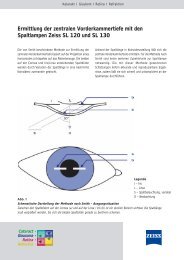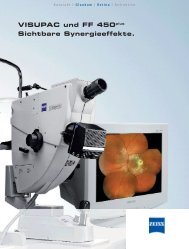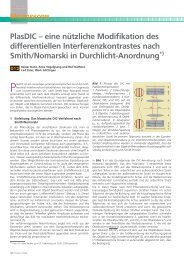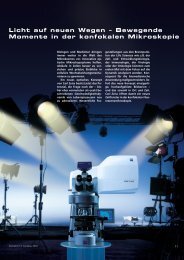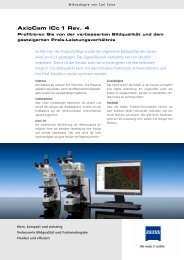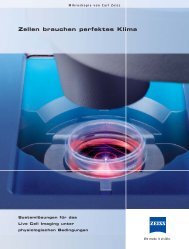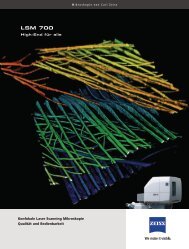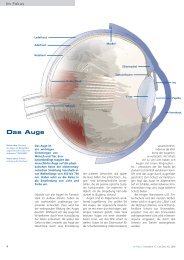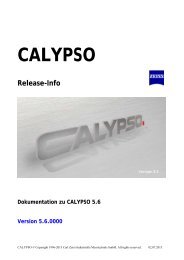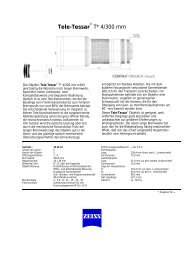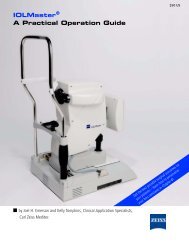FEMTO-LASIK and BEYOND - Carl Zeiss, Inc.
FEMTO-LASIK and BEYOND - Carl Zeiss, Inc.
FEMTO-LASIK and BEYOND - Carl Zeiss, Inc.
You also want an ePaper? Increase the reach of your titles
YUMPU automatically turns print PDFs into web optimized ePapers that Google loves.
22<br />
Ophthalmology WORLD REPORT<br />
ReLEx smile:<br />
My New Clinical<br />
St<strong>and</strong>ard<br />
ESCRS ReLEx smile Satellite Symposium Vienna, Austria<br />
Cataract & Refractive Surgery Today Europe<br />
Using this procedure in a high-volume clinic<br />
saves us from having to create a corneal flap.<br />
By Jesper Hjortdal, MD, PHD<br />
Figure 2. Refractive outcome after ReLEx for treatment of myopia <strong>and</strong><br />
myopic astigmatism up to -10.00 D.<br />
Figure 3. Safety of the ReLEx procedure, as expressed in the change in<br />
the numbers of lines of BCVA.<br />
vision correction. This has provided patients with incentive to<br />
come into our center <strong>and</strong> find out more about ReLEx flex <strong>and</strong><br />
ReLEx smile. Of course we still offer <strong>LASIK</strong> <strong>and</strong> PRK, as it is<br />
very important that the patient selects the treatment that is right<br />
for him or her specifically, but I have noticed that more often<br />
patients prefer one of the two ReLEx techniques.<br />
Conclusion: In the future, ReLEx procedures will be able<br />
to be performed through even smaller incisions than we use<br />
today. I have already attempted the use of 3-mm incisions in<br />
a number of ReLEx smile cases, <strong>and</strong> the results have been<br />
promising. The limiting factor at this point is the instruments<br />
we have to separate the lenticule in situ, which at this time are<br />
too large for smaller incision sizes. One solution may be the<br />
use of hydrodissection to separate the lenticule.<br />
I feel very lucky to be among the first surgeons to use ReLEx<br />
in a large patient population. To date, I have noticed a surge<br />
in the number of patients who ask for ReLEx by name, <strong>and</strong> I<br />
look forward to growing my number of treated patients even<br />
more. It is truly an exciting time to be a refractive surgeon. <br />
Iwork in an extremely high-volume, hospital-based clinic.<br />
In a typical day, I see up to 40 patients, treat a multitude of<br />
conditions, <strong>and</strong> correct various forms of refractive errors. My<br />
work is extremely rewarding—I find great joy in helping patients<br />
achieve better visual quality <strong>and</strong> in most cases spectacle<br />
independence—but it is also time-consuming, <strong>and</strong> anything I<br />
can do to safely reduce procedural times is helpful.<br />
Approximately 16 months ago, we switched from using <strong>LASIK</strong><br />
to lenticule extraction with ReLEx in the majority of my<br />
patients. We have performed approximately 900 procedures in<br />
this period. I have noticed a significant time-saving benefit. Of<br />
the two available ReLEx procedures, femtosecond lamellar<br />
extraction (ReLEx flex) <strong>and</strong> small incision lamellar extraction<br />
(ReLEx smile), I prefer the latter because I no longer need to<br />
create a corneal flap to perform the refractive correction. For<br />
the past 4 months, I have been using ReLEx smile whenever<br />
possible, promoting it as my new clinical st<strong>and</strong>ard for refractive<br />
surgery. We have thus far performed approximately 400<br />
ReLEx smile procedures.<br />
Differences: ReLEx is a simplistic but effective procedure that<br />
can today only be performed with the VisuMax femtosecond<br />
laser (<strong>Carl</strong> <strong>Zeiss</strong> Meditec, Jena, Germany); it is the only laser<br />
vision correction technique that uses a femtosecond laser to<br />
create a cut in the cornea <strong>and</strong> perform the refractive correction.<br />
With this technique, I am able to create the lenticule<br />
without ever having to break through the corneal surface. I<br />
typically use ReLEx for the treatment of high myopia, as this<br />
is the majority of patients who elect treatment due to reimbursement<br />
by the public health service. I treat patients with as<br />
much as -10.00D. Below I describe the differences between<br />
both ReLEx procedures.<br />
ReLEx flex. In the initial steps of the procedure, ReLEx flex is<br />
similar to <strong>LASIK</strong> in that a corneal flap is created <strong>and</strong> lifted;<br />
however, instead of ablating the tissue underneath the flap, the<br />
surgeon peels off a small refractive lenticule to provide the<br />
refractive correction. This is extremely easy to do, <strong>and</strong> after<br />
about 10 procedures I was comfortable with this technique.



